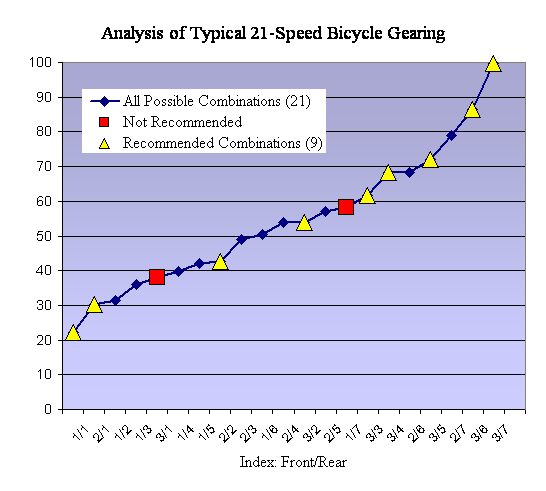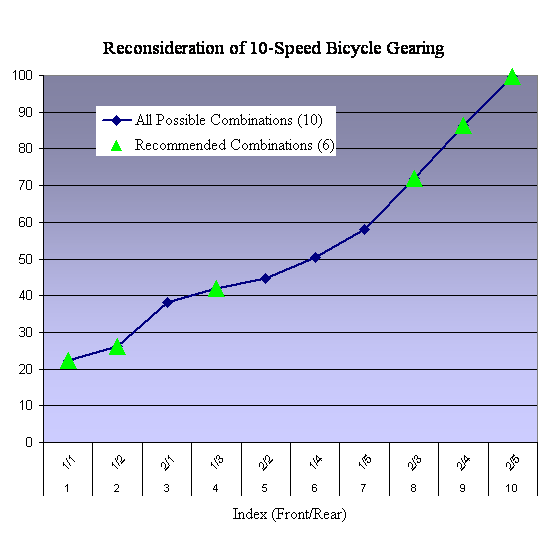|
Copyright ©2008 by Paul Niquette. All rights reserved. |
|
Copyright ©2008 by Paul Niquette. All rights reserved. |
 any solvers will regard the
question in the puzzle... any solvers will regard the
question in the puzzle...
How many 'speeds' are determined by the dérailleurs on Brigitte's mountain bike?...to be elementary in the extreme. To ascertain the number of 'speeds' for any bicycle, they will say, simply multiply the number of sprockets in the 'crank set' by the number of sprockets in the 'free wheel'. For the typical mountain bike, that's 3 times 7 equals 21 speeds. End of story. Not so fast.As explained in the solution to the puzzle entitled "Inches per What?" each so-called 'speed' of a bicycle is calculated by taking the ratio of the number of teeth in the front sprocket to the number of teeth in the rear sprocket and multiplying by the diameter of the rear wheel, which for mountain bikes is 27 inches. The graph below depicts all 21 possible combinations of sprocket selections for Brigitte's bike, each determining a 'speed' (in inches) -- "Dérailleur de Rigeur," let's say.  Two of the 21 'speeds' (38.1" and 58.2") are shown on the graph as not recommended. Here's why. One requires the chain to slant from the outermost front sprocket (#3) to the innermost rear sprocket (#1); the other requires the chain to slant from the innermost front sprocket (#1) to the outermost rear sprocket (#7). Experienced cyclists avoid chain jams by simply not using 3/1 and 1/7, contenting themselves with 19 speeds. Two of the remaining 19 combinations of sprockets, 2/4 and 3/2, produce the same exact 'speed' (54"). The previous sentence does not end with an exclamation point since it applies to Brigitte's bicycle and no others in the Niquette Collection. However, another pair of sprockets (3/4 and 2/6) produce a difference in speeds of less than a quarter of an inch (0.3%). Yet another (1/5 and 2/2) produce speeds within 3% of each other. For the solution to the puzzle, then, another couple of speeds can be dismissed, reducing the total to 17 speeds. Which is not to say that those speeds are completely excluded from use, inasmuch as... Two adjacent speeds must generally be accessed from one another by shifting both dérailleurs at same the time. That takes both hands. Perhaps you noticed, intermediate speeds can be accessed from four other non-adjacent speeds by shifting one dérailleur, thus for 54" (2/4 or 3/2), the rider has a choice of six combinations: 1/4, 2/2, 2/3, 2/5, 3/1, 3/3, 3/4. Two hands are required for shifting between adjacent speeds in all but these five pairs: 1/2-1/3, 1/4-1/5, 2/2-2/3, 3/3-3/4, 3/6-3/7. For the rider, whether road-racing or sight-seeing, that can be cumbersome if not dangerous. Nevertheless, limiting each shift to one dérailleur allows for a full range of recommended speeds (22" through 100") as follows: These speeds, which are depicted on the graph above by the yellow triangles, may afford the most practical answer to the question in the Dérailleur de Rigueur puzzle...
In analyzing Dérailleur de Rigueur for the mountain bike with 21 combinations of sprockets, we found that fully a dozen of them are not really all that useful -- certainly not for most riders, anyway. The main objective of multiple speeds is not granularity in the spacing between speeds but in enabling selections over a wide range of speeds -- from, say, 22" (smaller than a child's tricycle) all the way up to 100" or beyond (for competition in Tour de France). If all 21-speeds are not going to be used, why even have them? It was not that long ago that 10 speeds were quite acceptable. The graph below takes our Dérailleur de Rigueur analysis back to yesteryear. 
Finally, the recommended six speeds indicated by the green triangles are all accessible in sequence by one-handed shifting. The result of such a Dérailleur de Rigueur is a simpler mountain bike, with the full range of speeds at a reduction in unit manufacturing cost. |
Home Page Puzzle Page Logic and Reasonings The Puzzle as a Literary Genre